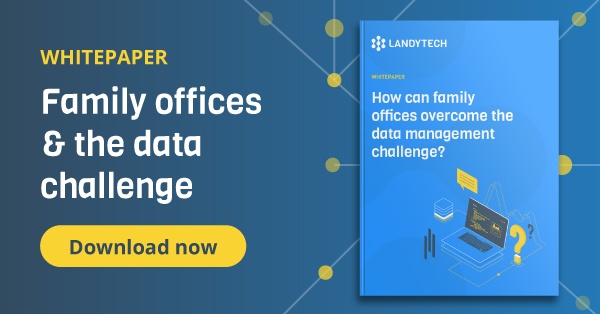Written by Landytech
13 Dec 2021Ultra-high-net-worth (UHNW) families typically have a plethora of accounts, portfolios, trusts and managers. Yet not having a complete picture of their holdings can cause them frustration. In light of this, they are increasingly turning to their family offices to deliver the consolidated reporting that will provide the visibility they desire.
Enrichment is an important element of the consolidated reporting process. This is because it adds colour and granularity to the raw data that the family office sources from its custodians and stores in its database. It does this by appending to the raw data descriptive metadata from secondary sources.
So, what should your family office know about enrichment?
1. Enrichment is a very broad term
Some custodians offer nothing more than basic data on assets and liabilities, their valuations, and any transactions that have occurred. Others may include a few additional data points – such as names, some descriptions, a country or currency – but granularity is limited.
Where custodians do provide a degree of colour around the raw data, in many cases it will be subject to fair usage policies that prohibit users from programmatically extracting data fields from the files. So, while the custodian file may feature information such as sectors and ratings, users are only allowed to look at it, not process it automatically.
Nevertheless, enrichment can be used to bring in prices, volumes, volume-weighted average prices, market capitalisations and sector information, along with some more sophisticated datasets.
2. It is usually expensive
Enriching data is costly. Some relatively open-source providers exist, but their datasets are limited. Using the big-data vendors with strong market and instrument coverage is expensive, with the most basic licensing packages starting at around $50,000 to $60,000 a year.
3. Licence terms and conditions can be prohibitive
Understanding what users are permitted to do with the data can get complicated. The licence terms and conditions typically prohibit any programmatic transformations and external reporting of the data. That means a family office will be prevented from incorporating the vendor’s data in any reports it wants to make available to its families or third parties. Furthermore, the family office is not allowed to store that data – or any calculations derived from it – in its database, creating a massive problem for producing downstream consolidated reporting.
Pricing is a case in point. If a data user calculates regressions and beta coefficients for some of its stocks using the data vendor’s prices, that is classified as derived data. The data licensee will not be allowed to report that information to anyone outside the organisation, or store the prices themselves, or the calculations based on those prices, in their database programmatically. Backdated licensing surcharges can be significant, with some running into the hundreds of thousands of dollars.
4. API endpoints must be integrated with the database
Along with their data licensing costs, different data vendor solutions have their own API endpoints. Firms will need to hire software developers with subject matter expertise to integrate those endpoints. More complex data –such as indices, ratings, and environmental, social and governance (ESG) enrichments – increase the difficulty of integrating the vendor solution and transforming the data into the database ecosystem of the family office. The enriched information will then need to feed back into the database and link with the objects already created in there so that the data can be used downstream.
Delivering consolidated reporting
Family offices increasingly aspire to deliver accurate, comprehensive and timely consolidated reporting to families. And families will increasingly come to expect it.
But to provide that high-quality consolidated reporting, family offices first need to tackle a host of complex challenges relating to the sourcing, transforming, storing and enriching of data. All these processes require sophisticated IT engineering and financial data expertise – skillsets that are in high demand and do not come cheap. Hefty data licence fees add to the cost.
Family offices have a choice. They can opt to hire an internal team of IT engineers and financial quants to develop and manage the necessary infrastructure. Or they can use a software-as-a-service capability to handle the end-to-end data management processes for them. What they can no longer afford to do, however, is ignore the growing calls from families for a consolidated reporting service.
To find out more about how family offices can overcome data management challenges, read our whitepaper below.
Related Content

The Top 10 Family Office Trends in 2024
To say the current economic environment is complex would be an understatement. With interest rates high and structural economic headwinds persisting, many economists believe we are in a “rolling recession” — a slow-growth period with industries...

How your family office should be sourcing wealth data
As today’s UHNW become more geographically dispersed and family officesbecome more sophisticated in their investment functions and allocation strategies,portfoliosnowconsist of multiple asset classes, custodians and currencies, and investments...
-1.jpg)
5 ways to improve productivity in your family office
As family offices attempt to modernise, many are facing productivity challenges due to out-of-date, disparate internal systems andheavily manual processes. Naturally, there are inherent risks associated with such inefficiencies, including missed ...




